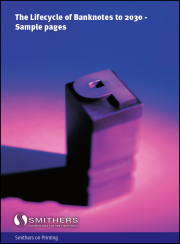
|
시장보고서
상품코드
1757087
지폐의 라이프 사이클(-2030년)The Lifecycle of Banknotes to 2030 |
||||||
주요 사실
- 세계의 지폐 인쇄 시장 규모는 2029년에 171억 달러에 달할 것으로 예측되며, 2024년부터 CAGR 5.3%로 성장할 것으로 전망됩니다.
- 2023년 미국에서 유통하고 있는 지폐는 546억 장으로, 액면 총액은 2조 3,000억 달러였습니다.
비접촉식 결제와 디지털 지갑의 우위성이 높아짐에도 불구하고 지폐는 경제 탄력성, 금융포섭, 문화적 정체성, 프라이버시에 필수적인 존재로 남아 있습니다. 2030년을 향해, 지폐의 라이프사이클은 첨단 기술의 통합, 진화하는 공적 요구, 보안, 지속가능성, 접근성의 중시에 의해 큰 영향을 받을 것으로 보입니다.
본 보고서에서는 현재 지폐의 라이프사이클과 지폐의 디자인, 생산, 유통에 관련된 단계를 매핑하여 현금 사이클의 각 단계를 상세하게 분석하고 있으며, 지폐산업 내의 변화와 지정학적 요인이 향후 5년간 이 라이프사이클에 미치는 영향을 다루고 있습니다.
목차
주요 요약
서문 및 조사 기법
지폐 산업 : 주요 촉진요인 및 동향
- 개요
- 서문
- 현금 사용은 세계적으로 감소하고 있습니다.
- 현금은 여전히 견고하고 안전합니다.
- 환경의 지속가능성 및 라이프사이클의 최적화
- 보안 위협 및 위조
- AI : 광대한 가능성 실현
- 관세 연도
- 전략적 인수 및 산업변혁
지폐 디자인 : 컨셉에서 청사진까지
- 개요
- 지폐의 수명주기에서 디자인의 역할
- 지폐의 디자인 : 영구적인 진화
- 보안 강화
- 문화적, 사회적 반영
- 현재 사례 연구 : 새로운 유로-5년간 인기 콘테스트
- 환경에 대한 배려
- 지폐의 디자인 : 오늘의 과제에 대한 대응(2030년)
- 지속가능성
- 지폐의 디자인 : 고객을 이해하고 배웁니다.
- AI와 디자인 : 보완적인 역할
지폐의 기재 및 보안 기능 기술
- 개요
- 기재 : 종이, 폴리머 및 하이브리드
- 지폐의 기재(2030년)
- 보안 기능 : 명시적, 기계 판독 가능
- 주요 보안 기능 : 명시적인 광학 기술
- 사례 연구 : 왜 1s가 중요한가?
- 기계 판독 가능 보안 기능
- 틈새 산업에서 독자성을 유지하는 것은 어렵습니다. : 횡단적인 동향
- 지폐의 기재 및 보안 기능 : 과제(-2030년)
- 지폐의 기재 및 보안 기능 : 라이프 사이클(2030년)
- 결론
지폐의 수명 주기 : 생산(-2030년)
- 개요
- 「지폐는 살 수 없습니다」 : 인쇄업자의 신조
- 세계의 지폐 생산
- 지폐 인쇄 : 혁신적인 기술(-2030년)
- AI : ChatGPT를 넘어
- 디지털 인쇄의 사례
- 자동화 및 스마트 매뉴팩처링
- 기술에 의한 지속가능성
- 기술 및 혁신을 통한 전략적 변화
지폐의 수명 주기 : 현금주기 변화(-2030년)
- 개요
- 현금주기 : 지속적인 가치 흐름
- 현금주기(2030년)
- 과제 1 : 현금의 사용을 줄인다
- 현금 사용 : (잘못된) 정확한 표현?
- 사재기 및 국외 이전
- 과제 2 : 운영 비용 절감
- 과제 3 : 보다 성공적인 위조 위협
- 시나리오 : 현금 순환과 위조 위기
- 지폐 수송 : 움직임의 합리화
- 보안 물류 네트워크
- 집중형 발행 모델 및 분산형 발행 모델
- 지폐의 수명의 끝 : 새로운 시작의 추진
- 캐시 사이클의 미래 : 애널리틱스
- 결론
지폐의 수명주기 : 세계 전망(-2030년)
- 개요
- 서유럽
- 유로권
- 동유럽
- 북미
- 중남미
- 아시아태평양
- 호주
- 아프리카
Key facts:
- The global banknote printing market is expected to increase in value to $17.1 billion in 2029, a CAGR of 5.3% from 2024
- In 2023, there were 54.6 billion US banknotes in circulation, with a combined face value of $2.3 trillion.
Despite the growing dominance of contactless payments and digital wallets, banknotes remain indispensable for economic resilience, financial inclusion, cultural identity, and privacy. Towards 2030, the banknote lifecycle will be greatly influenced by the integration of advanced technology, evolving public needs, and a strong emphasis on security, sustainability, and accessibility.
This report maps out the current lifecycle of a banknote, and the steps involved in the design, production and circulation of banknotes. It includes a detailed analysis of each stage in the cash cycle, and focuses on how changes within the banknote industry and geopolitical factors will influence this lifecycle over the next five years.
Key Questions:
- What forces within the market are driving or hindering banknote use?
- Which stages of lifecycle are affected by technological disruptions or developments?
- How is the use of digital and physical currencies balanced geographically?
- What is the influence of Central Bank Digital Currencies on the lifecycle of banknotes?
This report is essential to:
- Organisations active in the printing and distribution of cash
- Central banks, state printers and mints
- Security print consultants and analysts
Table of Contents
Executive summary
Introduction and methodology
- Report scope
- Report objective
- Geographic coverage
- Methodology
- Definitions and abbreviations
Banknote industry: key drivers and trends
- Overview
- Introduction
- Global usage of cash is declining
- Cash remains resilient and secure
- Emergence of Central Bank Digital currencies (CBDCs)
- Environmental sustainability and lifecycle optimization
- Security threats and counterfeiting
- Artificial intelligence: unlocking vast potential
- Phy-gital hybrids AKA "smart" banknotes
- The tariff years
- Strategic acquisitions and industry transformation
Banknote design: concepts to blueprints
- Overview
- Role of design in the lifecycle of banknotes
- Design and pre-production
- Production and printing
- Quality control and inspection
- Distribution and circulation
- End-of-lifecyle
- Banknote design: perpetual evolution
- Increased security
- Cultural and social reflection
- Current case study: the new Euro - a five-year popularity contest
- Public input
- Environmental considerations
- Banknote design in 2030: meeting today's challenges
- Designing for security
- Designing for digital coexistence and convergence
- Sustainability
- Designing for durability
- End-of-life design and recycling
- Banknote design: learning and knowing your client
- AI and design: complementary roles
- Generative design and aesthetic innovation
- Accelerated design process
- Predictive counterfeit mitigation
- Behavioral analytics and human-centered design
- Lifecycle simulation and durability optimization
- The challenges
Banknote substrates and security feature technologies
- Overview
- Substrates: paper / polymer / hybrids
- Cotton-based substrates (17th century - current)
- Introduction of polymer substrates (1980s-2000s)
- Composite polymer-paper hybrids (2010s-present)
- Current substrate landscape (2020s)
- Banknote substrates in 2030
- Expansion and Refinement of polymer substrates
- Rise of composite substrates
- Recycled materials, extended lifecycles
- Substrates designed for embedded digital features
- Substrate-level security features
- Real-time traceability and lifecycle monitoring
- Nanomaterial and smart material integration
- Security features: overt & machine-readable
- Primary security features: overt optical technologies
- Case study: why 1s matters? The perception of 3D effects
- Perceiving the benefits of 3D Security features
- Machine-readable security features
- Tough to be unique in a niche industry: cross-cutting trends
- The coin-banknote boundary
- Integration at the substrate level
- Banknote substrate and security features: challenges to 2030
- Technological obsolescence assists counterfeiters
- Machine-readable features and BEMS
- The durability of security
- Cost of innovation
- Integration complexity
- Public acceptance and usability
- Banknote substrate and security features: the 2030 lifecycle
- A. Design phase
- B. Production phase
- C. Distribution and logistics
- D. Circulation and usage
- E. End-of-life management
- Conclusion
Banknote lifecycle to 2030: production
- Overview
- "You cannot buy a banknote": a printwork's creed
- Banknotes are instruments of trust, not commodities
- Counterfeiting isn't just a crime - it's a national security threat
- High security printers must guarantee value transfer
- Central banks are custodians
- Printers create "error-free" value
- Global banknote production
- Current status: 2020-25
- Future outlook: 2025-30
- Staying ahead of the counterfeiters
- Sustainable lifecycle
- The cash paradox
- Banknote printing to 2030: innovative technologies
- Artificial intelligence: beyond ChatGPT
- AI-designed banknote security printing patterns
- Simulation of substrate and ink interactions
- Intelligent quality control
- Predictive maintenance and workflow optimization
- The case for digital printing
- Greater flexibility and customization
- Streamlined prototyping and development cycles
- Enhanced security potential
- Cost and efficiency benefits
- Challenges in adoption and Integration
- Automation and smart manufacturing
- Cybersecurity essentials
- Sustainability through technology
- Eco-friendly substrates
- Sustainable and secure inks
- Energy-efficient printing processes
- Strategic transformation through technology and innovation
Banknote lifecycle in 2030: transforming the cash cycle
- Overview
- Cash cycle: the perpetual value flow
- Step 1: Central Bank issuance to commercial banks
- Step 2: distribution into the economy
- Step 3: recirculation and handling
- Step 4: destruction of unfit notes
- Step 5: reissue and replacement
- The cash cycle in 2030
- Challenge #1: decreasing cash usage
- Cash usage: (Mis) accurate representations??
- The CIC/GDP ratio
- "Transactional cash" data
- Cash sharing measures
- Hoarding and off-shoring
- Challenge #2: reducing operational costs
- Cash access and the ATM landscape
- Growing ATM networks
- Energy-efficiency
- Data-driven optimization
- Increased cash recycling points
- Banknote recirculation and fitness sorting automation
- Challenge #3: smarter counterfeiting threats
- Scenario : the cash cycle and a counterfeiting crisis
- Case #1: advanced economies
- Surge in digital payment adoption
- Increased government support for digital infrastructure
- Greater scrutiny of anti-fraud capabilities in digital platforms
- Case #2: emerging market economies
- Slower and more fragmented shift to digital payments
- Economic disruption in the informal sector
- Limited institutional capacity to respond
- Opportunity for leapfrogging-if managed well
- Case #1: advanced economies
- Banknote transportation: streamlining movement
- Secure logistics networks
- Centralized vs distributed issuance models
- A banknote's end of life: fueling a new beginning
- Evolving practices
- Recycling and reuse - a circular economy?
- The future of the cash cycle: analytics
- Optimizing currency distribution and inventory management
- Forecasting demand through AI and machine learning
- Enhancing ATM and Cash-in-transit efficiency
- Lifecycle management and banknote durability
- Policy development and access to cash
- Integrating physical and digital currency metrics
- Vendor oversight and ecosystem management
- Conclusion
Banknote lifecycle in 2030: global outlooks
- Overview
- Western Europe
- Design and substrate
- Production and manufacturing
- Circulation and use
- Sorting, fitness, and reissuance
- End-of-life and sustainability
- Eurozone
- Design and substrate
- Production and manufacturing
- Circulation and use
- Sorting, fitness, and reissuance
- End-of-life and sustainability
- Eastern Europe
- Design and substrate
- Printing and production
- Circulation and public use
- Sorting and fitness
- End-of-life and recycling
- North America
- Design and substrate
- Production and manufacturing
- Circulation and use
- Sorting, fitness, and reissuance
- End-of-life and sustainability
- South & Central America
- Design and substrate
- Production and manufacturing
- Circulation and use
- Sorting, fitness, and reissuance
- End-of-life and sustainability
- Asia-Pacific
- Design and substrate
- Production and manufacturing
- Circulation and use
- Sorting, fitness, and reissuance
- End-of-life and sustainability
- Australia
- Design and substrate
- Production and manufacturing
- Circulation and use
- Sorting, fitness, and reissuance
- End-of-life and sustainability
- Africa
- Design and substrate
- Production and manufacturing
- Circulation and use
- Sorting, fitness, and reissuance
- End-of-life and sustainability
Key Facts and Figures
- IGNIS ExNihilo concept note from Bundesdruckerei, front and back surfaces
- The new Euro, banknote approval process
- Impacts of key trends/drivers on the banknote lifecycle
- Banknotes substrates investigated by key features
- Data sources for cash analytics across the cash cycle


















